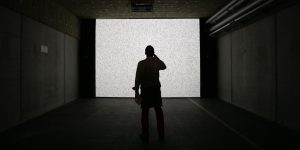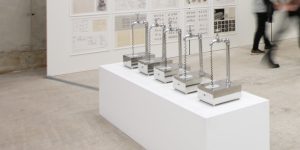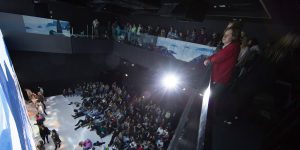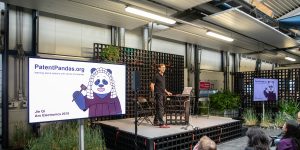Exhibitions, Projects

data.tron
Ryoji Ikeda (JP)
How many points are there in a line? What is the number of numbers? How can we verify that the random is random? data.tron is part of the datamatics project, a series of experiments that explore such questions both physically and mathematically. Visitors will experience the vast universe of data in the infinite between 0 and 1. data.tron is an audiovisual installation in which each single pixel of visual image is strictly calculated by mathematical principle, composed of a combination of pure mathematics and the vast sea of data present in the world. These images are projected onto a large screen, heightening and intensifying the visitor’s perception and total immersion in the work.

Listening capsules (light version)
Thomas Barbé (FR), the Random(lab)
Our body is a tactile receiver of all musical waves: we perceive them through our skin, muscles, nerves, bones, etc. The listening capsules immerse the viewer in “somesthetic” compositions generated live by an algorithm. The intention is to take the listener out of his usual sound environment in order to invite him to renew his listening experience. These waves, sinusoidal frequencies, are composed and synthesized generatively by a software specifically developed for the installation, the sinoto.

THE COMPUTATION CENTER [CENTRO DE CÁLCULO] AT MADRID UNIVERSITY. 1966-1973
The Computation Center at Madrid University (CCUM) is an example of how computation centers, mathematicians and some private computer companies became generators of interaction between technology and other disciplines.

Animation Festival @ Deep Space 8K - Part 2
Serial Parallels | Influencers | In Trance It | Beauty = Function

Ars Electronica History Day
The History Day conferences are dedicated to the anniversary celebrations of Ars Electronica. After 40 years in existence, we reflect on the various forms of digital media art that emerged during this time and were embedded and presented in the festival. Pioneers of artistic movements with strong impacts on the digital revolution from all around the globe will discuss outstanding ideas, practices and contributions from the intersection between art and technology.

Ting*
Tromarama – Febie Babyrose (ID), Herbert Hans (ID), Ruddy Hatumena (ID)
This video is about reunion; there are three mugs, which always appear in the video that represents the three of us. We can see all the tableware run away through the fence and play around in the park, but at the end of the day they must go back into the cupboard and be ordinary tableware again. This video expresses how we felt at that time, when our daily routine at the office occupied our playing time.

Animation Festival @ Deep Space 8K - Part 1
Boy transcoded from phosphene | Promenade (excerpt) | WHERE DO WE GO | Seven Experiments in Procedural Animation | tx-reverse

PatentPandas.org
Jie Qi (US), Carol Lin (US), May Qi (US), Ira Winder (US)
PatentPandas.org is a resource built to explain (scary!) patent law using (not-scary!) panda comics. The website has three core parts: Resources: information pages that explain the patent system (like prior art, what is patentable, infringement, etc.) using friendly language and humorous panda comics. Stories: accounts by everyday inventors who had adventures (or misadventures) involving patents and highlights what they learned from their experiences. Get Help: for innovators who are in need of legal support, we compiled a list of pro bono law clinics that offer to help innovators referred from patentpandas.org

Japanese Media Art Timeline Infographics Project
Atsuhito Sekiguchi(JP), Hiroko Myokan(JP), Minoru Noma (JP), Keiko Kobayashi (JP), Ryoji Tanaka (JP)
We are trying to build a history of Japanese media art from the event, with the artistic support of company Mesena (mécénat) and through the student-teacher relationships at the educational research institute. It will consist of an infographic that clearly displays the relationship between the winning projects at PRIX ARS Electronica and those at the Japan Media Art Festival.

Living Mirror
C-Lab – Howard Boland (UK), Laura Cinti (UK)
A mirror consisting of a liquid filled with bacteria. A camera scanning your face creates a magnetic field with the information, to which the bacteria respond. The result is that you look at a portrait of yourself, designed by bacteria.


